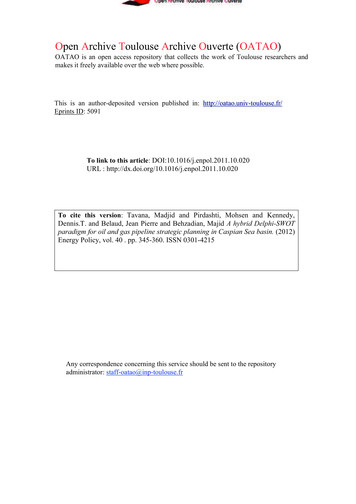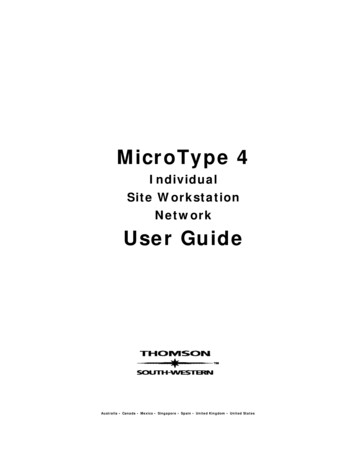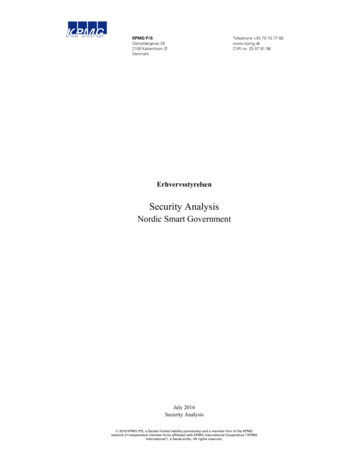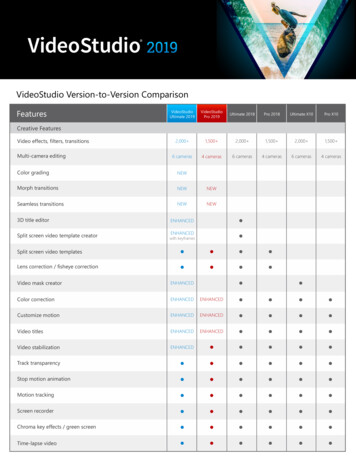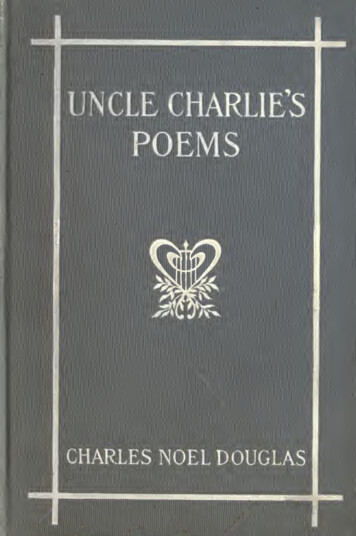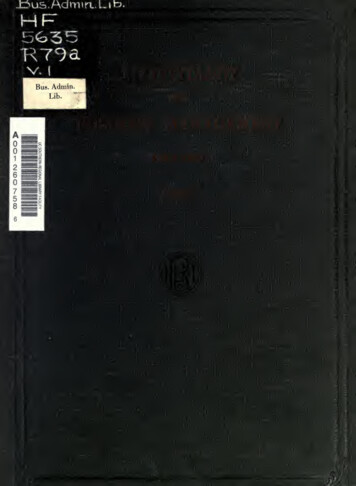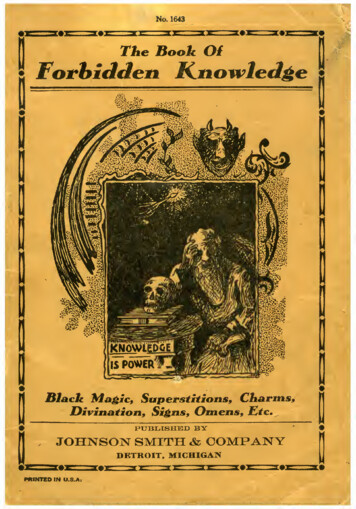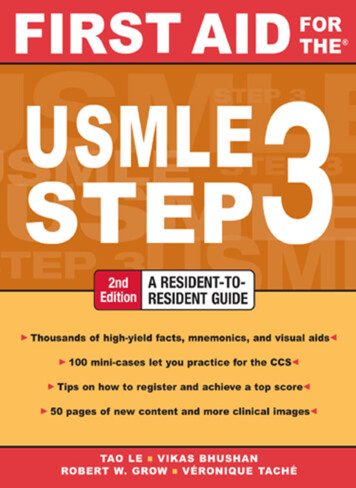![Archive Final Version[1]](/img/5/2007.jpg)
Transcription
ArchiveA Journal of Undergraduate HistoryVolume 10, May 2007Executive DirectorEmily YoungEditorial BoardMichael X. Albrecht, Claire Allen, Kerry Bryan, Tommy Greenfield,Katherine Kaliszewski, Sarah M. Klentz, Rengyee Lee,Alex Leites, Trevor C. Leverson, Angela Manderfeld,Peter Storm McGarraugh, Whitney Polenske, Liana Prescott,Katherine V. Tondrowski, Michelle Turcotte, Steven M. Weber, Jonathan WuFaculty AdvisorProfessor Laird BoswellPublished at the University of Wisconsin-MadisonPrinting services provided by DoIt Digital PublishingProduced in conjunction with the Lambda-Xi Chapter of Phi Alpha Theta History Honor SocietyFunded through a grant by the Associated Students of Madison and theUW-Madison History Department
2ArchiveDirector’s NotesThis year marks the tenth anniversary of Archive, and judging by the number of submissions wereceived this past February, the journal will continue to be successful in the years to come. Inaddition to showcasing the variety of undergraduate historical work at UW-Madison – RengyeeLee’s paper on the Secret War in Laos, Trevor Leverson’s ‘Soviet’ Cinema, and Claire Allen’spaper about early Christian attitudes toward war – this volume of Archive includes an excerpt from asenior thesis (Trevor Leverson’s work on the Byzantine ‘Holy Man’) and two very local pieces:Aaron Groth’s environmental history of Madison’s Picnic Point, and Tommy Greenfield’s analysisof UW’s own Charles Van Hise.The Archive editorial board members deserve recognition for doing an amazing job reading, talkingabout, and editing this year’s submissions. Their insight was helpful and greatly appreciated. Morethanks go to our advisor Professor Laird Boswell and History Department Chair David McDonaldfor securing additional funding, and to Liz Preston, the History Department’s undergraduate advisor,for enthusiastically supporting Archive. I would also like to thank Eli Persky, president of the UWchapter of Phi Alpha Theta, for answering all the questions I had for him this semester. Of course,Archive would not be possible if not for the funding from the Associated Students of Madison andthe great work of the staff at DoIt Digital Publishing & Printing. Finally, I would like to personallythank my family, friends, and especially my roommate Deanna for being there for me during thissometimes difficult semester and throughout my years in Madison.Emily YoungMadison, WisconsinApril 19, 2007
A Journal of Undergraduate HistoryAbout ArchiveIn 1997, the UW-Madison chapter of Phi Alpha Theta, with the support of theUW-Madison History Department, created Archive: A Journal of UndergraduateHistory. Thus far, Phi Alpha Theta has sponsored the publication of ten volumesof the journal. Students wishing to work on Archive’s staff are not required to be ahistory major or a member of Phi Alpha Theta. Members of the staff worktogether to select papers, publicize the journal, and edit the chosen submissions.Archive will accept papers for next year’s volume until February 14, 2008.Requirements and submission forms can be found at http://uwho.rso.wisc.edu/archive.shtml.About Phi Alpha Theta and the Undergraduate HistoryAssociation (UW-Madison)The UW-Madison chapter of Phi Alpha Theta and the Undergraduate HistoryAssociation function as one group. Together, they provide student representativesto the History Department’s Undergraduate Council, hold regular meetings onhistorical topics, and publish Archive. Information about the group can be found athttp://uwho.rso.wisc.edu.3
4ArchiveAbout the ContributorsClaire Allen is a junior majoring in Anthropology and History and obtaining a certificate inReligious Studies. She wrote "Defining 'the Camp of Light and the Camp of Darkness:' EarlyChristian Attitudes Toward War" for Professor Paul Stephenson's seminar on Holy War. Aftergraduation, Claire plans to pursue either South Asian Studies or Law, or perhaps both.Tommy Greenfield wrote “Our Charles R.: Progressivist, Procorporatist, Conservationist” forProfessor John Cooper’s U.S. 1877-1914 course in the fall of 2006. He currently works for FirstRockford Group, Inc., and plans to graduate in fall 2007.Aaron Asa Pierce Groth wrote “Picnic Point: An Environmental History” while a history major atUW-Madison. Originally written for Professor Cronon in Fall 2004, Aaron continued his researchwhile interning with the Lakeshore Nature Preserve for a seminar with Professor Cal DeWitt inSpring 2006. Aaron graduated in May 2006. Aaron is now an Environmental Peace CorpsVolunteer in northern Peru. He hopes to continue graduate studies in environmental history andhistorical geography.Rengyee Lee is a senior majoring in History, Political Science, and Neurobiology with a certificatein East Asian Studies. He wrote "Lessons from the Secret War: Guerrillas, Bombs, and the CIA" forProfessor Alfred McCoy's “CIA Covert Warfare & US Foreign Policy” spring 2005 inauguralseminar. After graduation, he plans to pursue a Ph.D. in Political Science.Trevor Leverson is a senior majoring in honors history and economics. He submitted "The Rise of'Soviet' Cinema" to Professor Francine Hirsch as the term paper for an Advanced History Seminaron, surprisingly enough, Soviet Cinema (Spring 2004). His thesis, "The Economic Impact of the'Holy Man' in Byzantium 300-600 CE" was submitted to Professor Paul Stephenson during thespring of 2006. After graduation he plans to teach high school for a year and then to go to lawschool.
The Rise of ‘Soviet’ CinemaTrevor C. LeversonIn the early 1920’s the feature film not only presented the Communist Party with a newweapon for propaganda, but also a challenge for its effective use. The Communist Party saw film asso important that it consolidated the industry after the 13th Party Congress into Sovkino, agovernment run film company that funded Soviet films. Narkompros1 and its minister, AnatoliLunacharsky, addressed the problem by laying down guidelines for film that might achieve‘socialist’ propagandist ends. But in reality these prescriptions left a lot of room for interpretation.This gave rise to an experimental period in Soviet film. From 1922 on, the writings andcinematic works of intellectual-filmmakers, and especially those of Sergei Eisenstein and DzigaVertov, greatly influenced Soviet cinema’s direction. Ultimately, however, these directors and theirfilms did not accomplish the goals set forth by the party line: the main one being to make the publicmore accepting of Communist doctrine. By the 1930’s, when the Party had observed the effects ofthese films on audiences, Eisenstein and Vertov received heavy criticism for their artisticcinematography and were derogatorily labeled as formalists. Communist Party officials wereunfamiliar with film in the early 1920’s, and they viewed popular Soviet films as a necessity for thepropagation of Communism. More than anything else, the experimental films of Eisenstein andVertov showed the Party by the 1930’s that its filmic propaganda could accomplish the Party’spropagandist objectives more fully if its construction did not hinge on intellectual theories andtechniques.In the 1920’s the Russian people did not accept Communism with open arms. Rather,Lenin recognized that his Party needed to ‘educate’ the Russian population, transforming it intosomething more malleable to the Party cause. By this time, Lenin had an idea as to what the Partyneeded for its propaganda to succeed in this mission, as his 1902 book What is to Be Done?demonstrated. Lenin provided Soviet propagandists with very clear examples of how such materialscould be created:In the making of propaganda one should look for a glaring and widely known factto audience, say, the death of an unemployed worker’s family from starvation, thegrowth of impoverishment, etc., and utilizing this fact, known to all, will direct hisefforts to presenting a single idea to the ‘masses;’ he will strive to rouse discontentand indignation among the masses against this crying injustice, leaving a morecomplete explanation 21In English Narkompros translates to the Commissariat of Education, but in reality it was a governmental organ thatcontrolled media and propaganda.2Vladimir Lenin, “What Is to Be Done?” Found in: The Lenin Anthology, (New York: 1975 W.W. Norton & Co.), 16-17.
6ArchiveAs his conversations and writings in 1920 and 1922 illustrate, Lenin attempted to ascertain how theParty could effectively use the feature film for propaganda – as the feature film was a new mediumat the time. It seems clear from these writings that even Lenin was not quite sure of what he couldexpect from the nascent technology. In his 1922 “Directive on Cinema Affairs” - written toNarkompros and Anatoli Lunacharsky, its minister - Lenin seemed uncharacteristically unsure ofhimself:To be safe films of a propagandist and educational character should be tried out onold Marxists and literary men, so that we do not repeat the sad mistakes that haveoccurred several times in the past, when propaganda achieves the opposite effect tothat intended.3Similarly, in a 1922 conversation he had with Lunacharsky, Lenin seemed optimistic, though notquite certain of film’s possibilities. As Lunacharsky recalled, “he had an inner conviction of thegreat profitability of the whole thing if only it could be put on the right foot.”4 Lenin knew whatfilm could accomplish, but at the same time his unfamiliarity with the medium prevented him fromgrasping exactly how to attain these goals successfully.Lenin was not the only one. Other leading Party members had similar problems in thatthey understood that propaganda was meant to sell socialism to the people exposed to it, but theytoo did not necessarily know how to provide such results. Lev Trotsky, at this point he was still aleading member of the Communist Party as the Commissar of Military and Naval Affairs, expressedhis feelings very clearly in a 1923 Pravda article, “Vodka, the Church and the Cinema”:The fact that we have so far, i.e. in nearly six years, not taken possession of thecinema shows how slow and uneducated we are, not to say, frankly, stupid. Thisweapon, which cries out to be used, is the best instrument for propaganda apropaganda which is accessible to everyone, cuts into the memory and may be apossible source of revenue.5In 1923 Nikolai Bukharin voiced similar views in Communism and Education: “cinema must be aweapon for the organization of the masses around the task of the revolutionary struggle of theproletariat and socialist construction, and a means of agitation for the current slogans of the Party.”6By 1923 it was clear that leading Communist Party officials had a concrete objective for filmicpropaganda: they wanted it to be a weapon. But, as their limited amount of elaboration on thematter demonstrated, they were uncertain about how to accomplish this.These kinds of assertions by Trotsky, Bukharin, and others spurred enough discussion thatcinema, and its use as a ‘weapon,’ became a hot topic at the 13th Party Congress in 1924. The3Vladimir Lenin, “Directive on Cinema Affairs,” Found in: The Film Factory, ed. Richard Taylor and Ian Christie (NewYork: 1994 Routledge), 57.4Anatoli Lunacharsky, “Conversation with Lenin. I. Of All the Arts,” Found in: The Film Factory, ed. Richard Taylor andIan Christie (New York: 1994 Routledge), 57.5Lev Trotsky, “Vodka, the Church and Cinema,” Found in: The Film Factory, ed. Richard Taylor and Ian Christie (NewYork: 1994 Routledge), 96.6Nikolai Bukharin, Communism and Education, Found at 0/abc/10.htm, Accessed on 11 May 2005.
thA Journal of Undergraduate History7resolutions of the 13 Party Congress in May 1924 illustrated the Communist Party’s objective forpropaganda film:The cinema, ‘the most important of all the arts’, can and must play a large role inthe cultural revolution as a medium for broad educational work and communistpropaganda The cinema, like every art, cannot be apolitical. The cinema mustbe a weapon of the proletariat in its struggle for hegemony ‘it should be in thehands of the Party, the most powerful medium of communist enlightenment andagitation.’7The Congress declared a monopoly over film production and distribution, and liquidated privatefilm firms on the pretense that “these measures will lead to the elimination of the clashes andconflicts which have seriously delayed and disrupted work and will make possible the rational useof resources.”8 Three months later in a “Decree on the Establishment of Sovkino,” Sovnarkomestablished Sovkino9, which represented the first real Soviet monopoly over film production anddistribution. The capital that Sovkino, now representative of the whole film industry, gained fromprivate companies provided Soviet film directors with the necessary equipment and people for theirfilms.Even with a vehicle to produce film, proper Soviet filmmaking, an integral issue to theSoviet film problem, was left virtually unaddressed by the Congress. This responsibility fell toLunacharsky and Narkompros. As expounded by Sovnarkom’s aforementioned decree:The ideological guidance of the cinema industry is entrusted to Narkompros, and itis suggested that the forthcoming conference of the Narkompros of theAutonomous Republics should define the forms of ideological guidance for eachRepublic separately, together with the ways of unifying ideological guidancethroughout the whole territory of the Federation.10For this purpose Lunacharsky prepared “Revolutionary Ideology and Cinema - Theses.” Theinteresting aspect of his initial theses is that he based his ideas for a Soviet film aesthetic on Westerncinematography, which really hints at the fact he did not know what would make for effectiveSoviet propaganda:[In some ways] we must imitate the bourgeoisie: we must wherever possibleavoid tendentious films --- that is, large-scale films in which a didactic theme is7“Resolution of the Thirteenth Party Congress on Cinema,” in T
Archive A Journal of Undergraduate History Volume 10, May 2007 Executive Director Emily Young Editorial Board Michael X. Albrecht, Claire Allen, Kerry Bryan, Tommy Greenfield,

